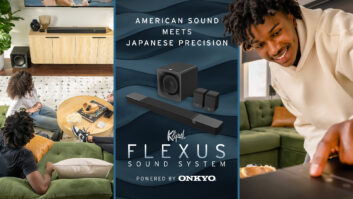Integrating Multi-Channel Audio In More Rooms Of The House
While there is nothing like a dedicated home theater room to wow your clients and make movie night a memorable experience, the reality is that most people spend more time watching TV and movies in their bedroom, den, or even in the kitchen. If you are not showing your clients what you can do with those rooms as well, you’re missing out on a huge market for high-quality audio systems in these smaller, “secondary” rooms.

Soundbars, like KEF’s HTF8003, are attractive, easy-to-install, and have benefited from some really outstanding research and development work over the past few years
THEATER-QUALITY IN SMALLER SPACES
Selling secondary systems is fundamentally no different than selling a full-scale theater room. Getting good video is not the issue; there are stunning HD video screens available in any size. The selling point is your ability to put theater-quality audio in smaller spaces.
First, you’ve got to give your clients an alternative to the small single-speaker “virtual surround system” that they might otherwise buy from their local big-box store. These all-in-one systems typically use a single speaker enclosure that contains amplifiers and a set of electronic processing algorithms to trick the listener into thinking they’re hearing multi-directional sound.
These systems can work reasonably well if the listener sits directly in front of the screen, looking directly at it. It’s a very small “sweet spot.” If you move a couple of feet to the left or turn your head, then the illusion is broken. The sound collapses to a not-so-impressive single-point source again. Point this out to people, and these systems lose much of their appeal. After all, who wants to be trapped in a small spot to get good sound in their bedroom?

In rooms where the entertainment system is not the primary function, like a bedroom, a ceilingspeaker- based audio system, like SnapAV’s new Episode line, makes a lot of sense.
IN-CEILING OPTIONS
There are better solutions, and clients will jump at them once they have had the chance to hear them in action. In rooms where the entertainment system is not the primary function, like a bedroom, a ceiling-speaker-based audio system makes a lot of sense. Many manufacturers offer purpose-built in-ceiling LCRs with midrange/high-frequency drivers that are angled right at the listening area, providing excellent intelligibility. Similarly, there are in-ceiling surround speakers that perform quite well in delivering immersive, non-localizable surround information. Combine these with any number of small, affordable, easy-to-hide subwoofers, and you have a quality audio system that integrates nicely into a room that was not “designed” for a theater system.
CONSIDER THE SOUNDBAR
Another way to go, which is even easier to install, is to use a soundbar. A soundbar is a long, slender cabinet that contains separate speakers for the front three Left-Center-Right (LCR) channels, or even for all five channels of a surround system.
Mounted under the flat-screen TV (either on the TV stand or with the TV on its wall-mount bracket), soundbars are attractive, easy-to-install, and have benefited from some really outstanding research and development work over the past few years.

The Atlantic Technology FS-7.0 produces sevenchannel surround sound in a single box with no DSP trickery needed.
A HYBRID APPROACH
Finally, a good hybrid alternative is combining a three-channel LCR soundbar with a pair of ceilingmounted surround speakers (along with that compact sub). A three-channel bar the same size as a typical fivechannel model can usually pack more quality and acoustic firepower into the same space, because that 40-inch span is only divided up among three independent speakers instead of five. The point is that there are a lot of good options. You could even forgo the actual surround speakers and just install the LCR soundbar.
Even if they skip the surround channels, most good LCR speakers will far outplay a small virtual surround system where it really counts: in the tonality, wide frequency response (“richness”), and clarity of the sound. Give a client a five-minute A/B demo, and most will gladly trade those faux-surround systems for a threechannel front soundstage that gets it right every time. The key to all of these solutions lies in managing (and by that I mean exceeding) the clients’ expectations by blowing them away with a world-class demo. Many customers will be skeptical that true high-quality surround sound can be attained by anything other than traditional box speakers or a high-dollar in-wall installation. Soundbars and ceiling speaker-based audio systems from reputable brands will deliver extremely high-quality sound, and do so in rooms where a freestanding speaker system just wouldn’t fit. A demo that closely replicates the size and dimensions of the client’s space is very convincing. Hearing is believing.”
Steve Feinstein is the director of marketing and product development for Atlantic Technology.





